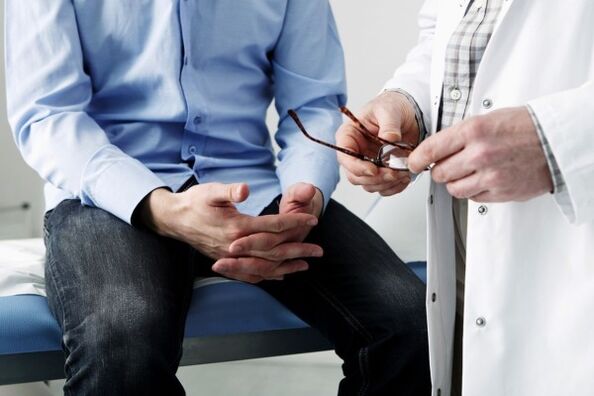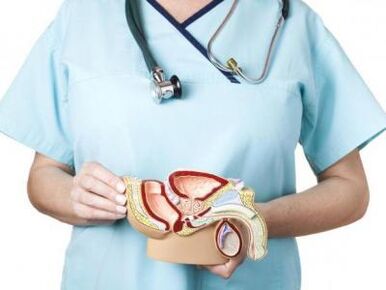Prostatitis is one of the most common urological diseases in men. And this is impressive even though the actual number of patients with the disease is much higher than the statistics recorded. This can be explained by the fact that prostatitis can occur in a latent state and the peculiarities of the diagnosis.
What does the prostate look like?
%20in%20men.jpg)
It is a small glandular-muscular organ. Localized in the pelvic region below the bladder, it fixes the initial section of the urethra.
It is the job of the gland to produce a secret that maintains the viability of sperm when mixed with sperm under various adverse conditions.
What about the prostate in men? Prostatitis is characterized by a number of urinary tract disorders, erectile function, decreased libido and other problems.
The lack of timely and appropriate treatment has sad consequences: one in four patients may experience one form or another of infertility as the prostate loses its ability to produce adequate amounts of reliable secretions to ensure sperm motility.
In men, the characteristic symptoms of prostatitis can occur not only with this disease, but also with a malignant tumor, prostate adenoma!
Signs
What could be the first "bell" of the disease? The variety of manifestations makes diagnosis difficult, so the presence of the disease cannot always be determined immediately. The initial symptoms of bacterial prostatitis differ from those of viral origin, and these differences are characteristic of the acute and chronic course of the disease.
However, there are major symptoms that should alert the patient:
- Problems with urination. It will be difficult and painful. This may indicate the initial symptoms of exacerbation. This is due to urethral obstruction due to an inflamed and enlarged prostate. Failure to take timely action leads to deterioration in well-being due to complete occlusion of the ureter.
- Sexual disorders. They are characterized by orgasm and weakened erections.
The disorders listed associated with this disease are far from the only ones and may be only one of the first signs of exacerbation.
In addition, the following signs are present:
- discharge from the urethra;
- floating fibers in the urine;
- special feelings during bowel movements;
- unpleasant burning sensation in the perineum.
The peculiarity of this disease is diversity. Therefore, a distinction should be made between the first symptoms of chronic bacterial prostatitis in men and acute in men.
In men, the causes of prostatitis are a sedentary lifestyle, a cold in the urogenital system.
Characteristics of different forms of prostatitis
The disease can occur in four most common forms.
Acute bacterial. It is usually diagnosed in patients under the age of thirty. The disease is characterized by fever - the temperature associated with prostatitis reaches 38 C and higher.

Due to prostate edema, the following can be observed:
- acute retention and frequency and pain of urination;
- prolonged discharge;
- discomfort in the lumbar region;
- erectile dysfunction.
Symptoms of sudden prostatitis are sometimes a general malaise, apathy.
Chronic bacterial. This form is typical of older patients. The disease progresses more calmly, but it can also get worse if there are factors that contribute to it. Sometimes the disease is asymptomatic.
Not bacterial. Although the presence of bacteria cannot be detected, this condition does not rule out its presence.
Prostatodynia. It is characterized by compaction of prostate tissue without symptoms of inflammation.
How to determine
The disease must be determined before prescribing effective treatment.

An integrated approach is important in diagnostics:
- Collection of medical history. To get a reliable picture of the course of the disease, the doctor finds out: the nature of the pain, the presence of secretions, sexual problems. Rectal finger analysis is performed to reveal swelling and pain in the prostate.
- Laboratory research. Without them, it is often impossible to identify the disease. This is especially true for chronic bacterial prostatitis. A urine culture is prescribed to find out the cause, which will help identify the pathogen that contributes to the exacerbation. Three urine samples are compared for reliability. Sometimes a biopsy and analysis of secretions may be needed. Venous blood is also analyzed for ESR content and leukocyte count.
- Ultrasound. Tomography (computer and magnetic resonance imaging). These tests are performed on both the prostate and adjacent organs.
How they are treated
Important! Medication is prescribed by a urologist. You can't participate in "self-classification" - it only makes the course of the disease worse!
Modern treatments for men's disease are varied. You can completely heal your prostate if you see a doctor in time.
The choice of form and methods is in accordance with the degree of complexity, the timing of the disease, the well-being of the patient and the characteristics of the body.
This determines the procedures that can be performed on an outpatient basis or in a hospital.
The treatment regimens for acute and chronic prostatitis in the exacerbation phase are virtually similar. With timely and appropriate treatment, the acute form is completely cured, achieving chronic long-term remission.
Important! The disease only gains an integrated approach to treatment - don’t ignore your doctor’s advice!
Drug therapy
Medication consists of antibiotics, non-steroidal analgesics, alpha-blockers. The former are commonly used to cure the bacterial form.

During the chronic course of the disease, alpha-blockers are prescribed to reduce prostate edema and relieve pain.
Important! We recommend that you use the tablets for the full course of treatment, which is usually at least six months long, and do not stop earlier, even if you feel better.
Non-steroidal drugs - for the treatment of acute forms.
Massage

It is an effective treatment. It improves the blood supply to the tissues of the gland and, when used in combination with other treatments, greatly increases the effectiveness of antibacterial and topical therapy.
Thanks to digital stimulation, it helps to secrete secretions from the prostate, which facilitates further self-secretion through the urethra.
Although patients often experience discomfort during the procedure, it is not recommended to ignore the massage.
Attention! In the acute form of the disease, massage treatments are forbidden - it is full of the spread of the infection!
Reflexology
Acupuncture and other methods improve the work of the central nervous system, normalize blood flow and metabolic processes in the body. Reflexology helps to relieve neuralgic pain and prevents the development of inflammatory processes. We recommend that you perform this procedure in combination with other treatment methods.
Hirudotherapy
This method can also be used to treat prostatitis. The use of leeches helps to increase the blood and lymph flow in the prostate and normalize its function.
Rectal suppositories
They directly affect the focus of the lesion and are therefore an extremely effective treatment. The antispasmodics, anabolic steroids and antibacterial substances in them are good for preventing exacerbations.
The effect of ichthyol and sea buckthorn cones is high.
Immune correction
Strengthening the immune system is recommended for all patients with such diseases. It helps to increase the body's resistance, it helps to slow down the progression of chronic prostatitis. The complex must use:
- natural methods - active exercise, walking in the fresh air, hardening;
- natural immunomodulators - ginseng, echinacea and others;
- multivitamin complexes.
Surgical intervention
At one time, they often resorted to a method of surgical treatment. In some cases, however, it did not bring much efficiency. In recent years, surgical manipulations have been used mainly for prostate abscesses or urethral strictures.
Thirty years old is a reason to think about your health. One in three patients who have crossed this age group have prostatitis, and one in two after 50. And this trend continues to this day.
Now that you know the first signs and treatment of prostatitis in men, you should be checked regularly by a doctor for timely detection to prevent the disease and further transition to a chronic form. What to do with prostatitis and where to go Every patient needs to know.
































